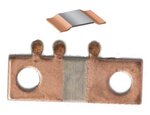oldev
Newbie level 3
After having to replace a few components in a system containing the current measurement circuit shown below, I have not been able to find a sensible and repeatable way of calibrating the circuit.
One approach was to set the input current to 1A, and turn R1 and R7 until the system output read 1A.
Then when changing the input to 10A, the system output is incorrect.
If I start by setting the input current to 10A and turn R1 and R7 until the system output reads 10A, then when I change the input to 1A, the system output is incorrect.
Another approach was to first, with input current set to 0A and with R1 to R4 junction shorted to 0V, turn R7 until the system output read 0A, and then attempt the above, yet only adjusting R1. This also produces incorrect results.
Any comments or suggestions which may shed light on a sensible and repeatable approach towards the calibration of this circuit will be appreciated.

One approach was to set the input current to 1A, and turn R1 and R7 until the system output read 1A.
Then when changing the input to 10A, the system output is incorrect.
If I start by setting the input current to 10A and turn R1 and R7 until the system output reads 10A, then when I change the input to 1A, the system output is incorrect.
Another approach was to first, with input current set to 0A and with R1 to R4 junction shorted to 0V, turn R7 until the system output read 0A, and then attempt the above, yet only adjusting R1. This also produces incorrect results.
Any comments or suggestions which may shed light on a sensible and repeatable approach towards the calibration of this circuit will be appreciated.


